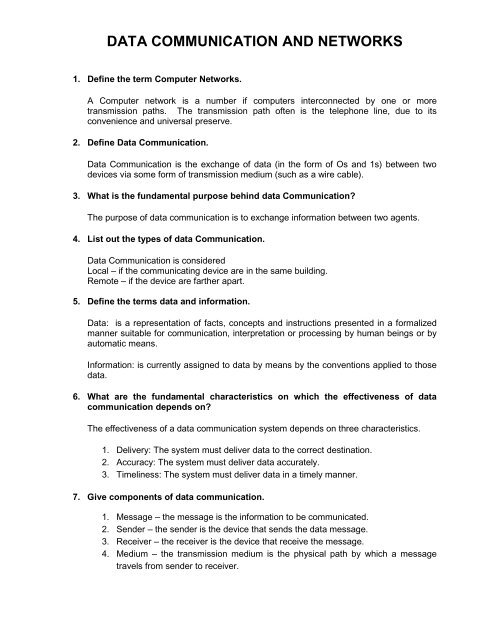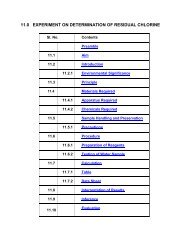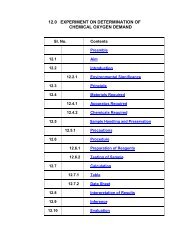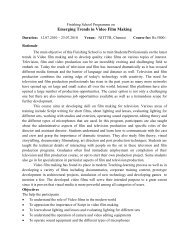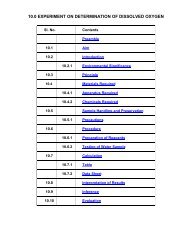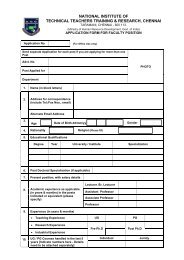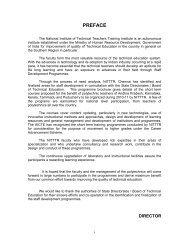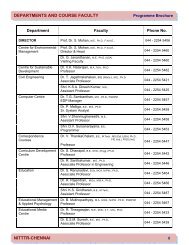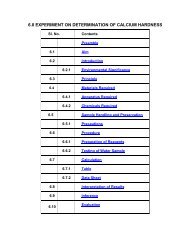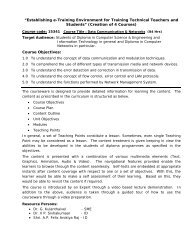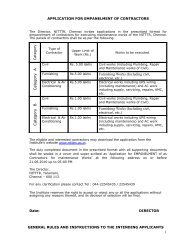DATA COMMUNICATION AND NETWORKS
DATA COMMUNICATION AND NETWORKS
DATA COMMUNICATION AND NETWORKS
Create successful ePaper yourself
Turn your PDF publications into a flip-book with our unique Google optimized e-Paper software.
<strong>DATA</strong> <strong>COMMUNICATION</strong> <strong>AND</strong> <strong>NETWORKS</strong>1. Define the term Computer Networks.A Computer network is a number if computers interconnected by one or moretransmission paths. The transmission path often is the telephone line, due to itsconvenience and universal preserve.2. Define Data Communication.Data Communication is the exchange of data (in the form of Os and 1s) between twodevices via some form of transmission medium (such as a wire cable).3. What is the fundamental purpose behind data Communication?The purpose of data communication is to exchange information between two agents.4. List out the types of data Communication.Data Communication is consideredLocal – if the communicating device are in the same building.Remote – if the device are farther apart.5. Define the terms data and information.Data: is a representation of facts, concepts and instructions presented in a formalizedmanner suitable for communication, interpretation or processing by human beings or byautomatic means.Information: is currently assigned to data by means by the conventions applied to thosedata.6. What are the fundamental characteristics on which the effectiveness of datacommunication depends on?The effectiveness of a data communication system depends on three characteristics.1. Delivery: The system must deliver data to the correct destination.2. Accuracy: The system must deliver data accurately.3. Timeliness: The system must deliver data in a timely manner.7. Give components of data communication.1. Message – the message is the information to be communicated.2. Sender – the sender is the device that sends the data message.3. Receiver – the receiver is the device that receive the message.4. Medium – the transmission medium is the physical path by which a messagetravels from sender to receiver.
5. Protocol – A protocol is a set of rules that govern data communication.8. Define Network.A Network is a set of devices (nodes) connected by media links. A node can be acomputer, printer, or any other device capable of sending and / or receiving datagenerated by other nodes on the network.9. What are the advantage of distributed processing?1. Security / Encapsulation2. Distributed database3. Faster problem solving4. Security through redundancy5. Collaborative processing10. What are the three criteria necessary for an effective and efficient network?1. Performance2. Reliability3. Security11. Name the factors that affect the performance of a network-performance of a network depends on a number of factors,1. Number of users2. Type of transmission medium3. Capabilities of the connected hardware4. Efficiency of software.12. Name of the factors that affect the performance of a network.1. Frequency of failure2. Recovery time of a network after a failure.3. Catastrophe.13. Name the factors that affect the security of a network.Network security issues include protecting data from unauthorized access and viruses.14. Define PROTOCOLA protocol is a set of rules (conventions) that govern all aspects of data communication.
15. Give the key elements of protocol.• Syntax: refers to the structure or format of the data, meaning the order in which theyare presented.• Semantics: refers to the meaning of each section of bits.1. Timing: refers to two characteristics.2. When data should be sent and3. How fast they can be sent.16. Define line configuration and give its types.- Line configuration refers to the way two or morecommunication devices attach to a link.- There are two possible line configurations:i. Point to point andii. Multipoint.17. Define topology and mention the types of topologies.Topology defines the physical or logical arrangement of links in a networkTypes of topology :- Mesh- Star- Tree- Bus- Ring18. Define Hub.In a star topology, each device has a dedicated point to point link only to a centralcontroller usually called a hub.19. Give an advantage for each type of network topology.1. Mesh topology:* Use of dedicated links guarantees that each connection can carry its own data load,thus eliminating traffic problems.* Robust and privacy / security.2. Star topology:* Less expensive than mesh.* Needs only one link and one input and output port to connect it any number ofothers.* Robustness.3. Tree topology:* same as those of a star.4. Bus topology:* Ease of installation.
* Uses less cabling than mesh, star or tree topologies.5. Ring topology:* A ring is relatively easy to install and reconfigure.* Each device is linked only to its immediate neighbors.• Fault isolation is simplified.20. Define transmission mode and its types.Transmission mode defines the direction of signal flow between two linked devices.Transmission modes are of three types.- Simplex- Half duplex- Full duplex.21. What is LAN?Local Area Network (LAN) is a network that uses technology designed to span a smallgeographical area. For e.g. an Ethernet is a LAN technology suitable for use in a singlebuilding.22. What is WAN?Wide Area Network (WAN) is a network that uses technology designed to span a largegeographical area. For e.g. a satellite network is a WAN because a satellite can relaycommunication across an entire continent. WANs have higher propagation delay thanLANs.23. What is MAN?* A Metropolitan Area Network (MAN) is a network that uses technology designed toextend over an entire city.* For e.g. a company can use a MAN to connect the LANs in all its offices throughouta city.24. Define Peer to peer processes.The processes on each machine that communicate at a given layer are called peer topeer processes.25. What is half duplex mode?A transmission mode in which each station can both transmit and receive, but not at thesame time.26. What is full duplex mode?A transmission mode in which both stations can transmit and receive simultaneously.27. What is internet?
• When two or more networks are connected they become an internetwork or internet.• The most notable internet is called the Internet.28. What is Internet ?The Internet is a communication system that has brought a wealth of information to outfingertips and organized it for our use.Internet – Worldwide network.29. List the layers of OSI model.- Physical- Data Link- Network- Transport- Session- Presentation- Application.30. Define OSI model.The open system Interconnection model is a layered framework for the design ofnetwork system that allows for communication across all types of computer systems.31. Which OSI layers are the network support layers?- Physical- Data link- Network layers.32. Which OSI layers are the user support layers?- Session- Presentation- Application.33. What are the responsibilities of physical layer, data link layer, network layer,transport layer, session layer, presentation layer, application layer.a. Physical layer – Responsible for transmitting individual bits from one node to thenext.b. Data link layer – Responsible for transmitting frames from one node to the next.c. Network layer – Responsible for the delivery of packets from the original sourceto the final destination.d. Transport layer – Responsible for delivery of a message from one process toanother.e. Session layer – To establish, manage and terminate sessions.
f. Presentation layer – Responsible to translate, encrypt and compress data.g. Application layer – Responsible for providing services to the user. To allowaccess to network resources.34. What is the purpose of dialog controller?The session layer is the network dialog controller. It establishes, maintains andsynchronizes the interaction between communicating systems.35. Name some services provided by the application layer.Specific services provided by the application layer include the following.- Network virtual terminal.- File transfer, access and management (FTAM).- Mail services.- Directory services.36. Define Network Virtual Terminal.Network Virtual Terminal – OSI remote login protocol. It is an imaginary terminal with aset of standard characteristics that every host understands.37. Define the term transmission medium.The transmission medium is the physical path between transmitter and receiver in adata transmission system. The characteristics and quality of data transmission aredetermined both the nature of signal and nature of the medium.38. What are the types of transmission media?Transmission media are divided into two categories. They are as follows:I. Guided transmission mediaII. Unguided transmission media39. How do guided media differ from unguided media?A guided media is contained within physical boundaries, while an unguided medium isboundless.40. What are the three major classes of guided media?Categories of guided media.a. Twisted – pair cable.b. Coaxial cable.c. Fiber – optic cable.
41. What is a coaxial cable?A type of cable used for computer network as well as cable television. The namearises from the structure in which a metal shield surrounds a center wire. The shieldprotects the signal on the inner wire from electrical interference.42. A light beam travels to a less dense medium. What happens to the beam in eachof the following cases:1. The incident angle is less than the critical angle.2. The incident angle is equal to the critical angle.3. The incident angle is greater than the critical angle.1. The incident angle is less than the critical angle.the ray refracts and moves closer to the surface.2. The incident angle is equal to the critical angle.the light bends along the interface.3. The incident angle is greater than the critical angle.the ray reflects and travels again in the denser substance.43. What is reflection?When the angle of incident becomes greater than the critical angel, a newphenomenon occurs called reflection.44. Discuss the modes for propagation light along optical channels.There are two modes for propagating light along optical channels.Single mode and multimode.Multimode can be implemented in two forms: step index or graded index.45. What is the purpose of cladding in an optical fiber? Discuss its density relative tothe core.A glass or plastic is surrounded by a cladding of less dense glass or plastic.The difference in density of the two materials must be such that a beam of lightmoving through the core is reflected off the cladding instead of being refracted into it.46. Name the advantage of optical fiber over twisted pair and coaxial cable.Higher bandwidth.Less signal attenuation.Immunity to electromagnetic interference.Resistance to corrosive materials.More immune to tapping.Light weight.
47. What is the disadvantage of optical fiber as a transmission medium?Installation / Maintenance.Unidirectional.Cost – More expensive than those of other guided media.48. What does the term modem stands for ?Modem stands for modulator / demodulator.49. What is the function of a modulator?A modulator converts a digital signal into an analog signal using ASK, FSK, PSK orQAM.50. What is the function of a demodulator?A de modulator converts an analog signal into a digital signal.51. What is an Intelligent modems?Intelligent modems contain software to support a number of additional functions suchas automatic answering and dialing.52. What are the factor that affect the data rate of a link?The data rate of a link depends on the type of encoding used and the bandwidth of themedium.53. Define Line coding.Line coding is the process of converting binary data, a sequence of bits, to a digitalsignal.54. For n devices in a network, what is the number of cable links necessary for mesh,ring, bus and star networks.Number of links for mesh topology : n (n – 1) / 2.Number of links for ring topology : n – 1.Number of links for bus topology : one backbone and n drop lines.Number of links for star topology : n.55. Write the design issues of datalink layer?1) Services provided to network layer.2) Framing3) Error control4) Flow control
56. What is datalink?When a datalink control protocol is used the transmission medium between systems isreferred to as a datalink.57. What is the main function of datalink layer?The datalink layer transforms the physical layer, a raw transmission facility to a reliablelink and is responsible for node to node delivery.58. What is a datalink protocol?Datalink protocol is a layer of control present in each communicating device thatprovides functions such as flow control, error detection and error control.59. What is meant by flow control?Flow control is a set of procedures used to restrict the amount of data that the sendercan send before waiting for an acknowledgement.60. How is error controlled in datalink controlled protocol?In a datalink control protocol, error control is activated by retransmission of damagedframe that have not been acknowledged by other side which requests a retransmission.61. Discuss the concept of redundancy in error detection.Error detection uses the concept of redundancy, which means adding extra bits fordetecting errors at the destination.62. What are the three types of redundancy checks used in data communications?- Vertical Redundancy Check (VRC)- Longitudinal Redundancy Check (LRC)- Cyclic Redundancy Check (CRC)63. How can the parity bit detect a damaged data unit?In parity check, (a redundant bit) a parity bit is added to every data unit so that the totalnumber of 1s is even for even parity checking function (or odd for odd parity).64. How can we use the Hamming code to correct a burst error?By rearranging the order of bit transmission of the data units, the Hamming code cancorrect burst errors.65. Briefly discuss Stop and Wait method of flow control?In Stop and Wait of flow control, the sender sends one frame and waits for anacknowledgement before sending the next frame.
66. In the Hamming code for a data unit of m bits how do you compute the number ofredundant bits ‘r’ needed?In the Hamming code, for a data unit of m bits, use the formula 2r > = m + r + 1 todetermine r, the number of redundant bits needed.67. What are three popular ARQ mechanisms?- Stop and wait ARQ,- Go – Back – N ARQ and- Selective Report ARQ.68. How does ARQ correct an error?Anytime an error is detected in an exchange, a negative acknowledgment (NAK) isreturned and the specified frames are retransmitted.69. What is the purpose of the timer at the sender site in systems using ARQ?The sender starts a timer when it sends a frame. If an acknowledgment is not receivedwithin an allotted time period, the sender assumes that the frame was lost or damagedand resends it.70. What is damaged frame?A damaged frame is recognizable frame that does arrive, but some of the bits are inerror (have been altered during transmission)71. What is HDLC?HDLC is a bit oriented datalink protocol designed to support both half-duplex and fullduplex communication over point to point and multiport link.72. Give data transfer modes of HDLC?1. NRM – Normal Response Mode2. ARM – Asynchronous Response Mode3. ABM - Asynchronous Balanced Mode73. How many types of frames HDLC uses?1. U-Frames2. I-Frames3. S-Frame74. State phases involved in the operation of HDLC?1. Initialization2. Data transfer3. Disconnect
75. What is the meaning of ACK frame?ACK frame is an indication that a station has received something from another.76. What is CSMA?Carrier Sense Multiple Access is a protocol used to sense whether a medium is busybefore attempting to transmit.77. Explain CSMA/CDCarrier Sense Multiple Access with collision detection is a protocol used to sensewhether a medium is busy before transmission but is has the ability to detect whether atransmission has collided with another.78. State advantage of Ethernet?1. Inexpensive2. Easy to install3. Supports various wiring technologies79. What is fast Ethernet?It is the high speed version of Ethernet that supports data transfer rates of 100 Mbps.80. What is bit stuffing and why it is needed in HDLC?Bit stuffing is the process of adding one extra 0 whenever there are five consecutive 1sin the data so that the receiver does not mistake the data for a flag. Bit stuffing is neededto handle data transparency.81. What is a bridge?Bridge is a hardware networking device used to connect two LANs. A bridge operates atdata link layer of the OSI reference model.82. What is a repeater?Repeater is a hardware device used to strengthen signals being transmitted on anetworks.83. Define router?A network layer device that connects networks with different physical media andtranslates between network architectures.84. State the functions of bridge?1. Frame filtering and forwarding2. Learning the address3. Routing
85. List any two functions which a bridge cannot perform?- Bridge cannot determine most efficient path.- Traffic management function.86. What is hub?Networks require a central location to bring media segment together. These centrallocations are called hubs.87. State important types of hubs.1. Passive hub2. Active hub3. Intelligent hub88. Mention the function of hub.1. Facilitate adding/deleting or moving work stations2. Extend the length of network3. It provides centralize management services4. Provides multiple interfaces.89. What is the main function of gateway.A gateway is a protocol converter90. A gateway operates at which layer.Gateway operates at all seven layers of OSI model.91. Which factors a gateway handles?Data rate, data size, data format92. What is meant by active hub?A central hub in a network that retransmits the data it receives.93. What is the function of ACK timer?ACK timer is used in flow control protocols to determine when to send a separateacknowledgment in the absence of outgoing frame.94. What are the types of bridges?1. Transparent bridge2. Source Routing bridgeTransparent bridge - Transparent bridge keep a suitable of addresses in memory todetermine where to send data
Source Routing bridge - Source Routing bridge requires the entire routing table to beincluded in the transmission and do not route packet intelligently.95. What are transreceivers?Transreceivers are combination of transmitter and receiver. Transreceivers are alsocalled as medium attachment unit (MAU)96. What is the function of NIC?NIC is used to allow the computer to communicate on the network. It supportstransmitting, receiving and controlling traffic with other computers on network.97. Mention different random access techniques?1. ALOHA2. CSMA3. CSMA/CD98. What is the function of router?Routers relay packets among multiple interconnected networks. They route packets fromone network to any number of potential destination networks on an internet.99. How does a router differ from a bridge?Routers provide links between two separate but same type LANs and are most active atthe network layer. Whereas bridges utilize addressing protocols and can affect the flowcontrol of a single LAN; most active at the data link layer.100. Identify the class and default subnet mask of the IP address 217.65.10.7.It belongs to class C.Default subnet mask – 255.255.255.192101. What are the fields present in IP address?Netid and Hostid.Netid – portion of the ip address that identifies the network.Hostid – portion of the ip address that identifies the host or router on the networks.102. What is flow control?How to keep a fast sender from swamping a slow receiver with data is called flowcontrol.
103. What are the functions of transport layers?The transport layer is responsible for reliable data delivery. Functions of transport layeri. Transport layer breaks messages into packetsii. It performs error recovery if the lower layers are not adequately error free.iii.Function of flow control if not done adequately at the network layer.iv.Function of multiplexing and demultiplexing sessions together.v. This layer can be responsible for setting up and releasing connections across thenetwork.104. What is segmentation?When the size of the data unit received from the upper layer is too long for the networklayer datagrams or datalink frame to handle, the transport protocol divides it in tosmaller, usuable blocks. The dividing process is called segmentation.105. What is Transport Control Protocol (TCP)?The TCP/IP protocol that provides application programs with access to a connectionoriented communication service. TCP offers reliable flow controlled delivery. Moreimportant TCP accommodates changing conditions in the Internet by adapting itsretransmission scheme.106. Define the term (i) Host (ii) IPa. Host : An end user’s computer connection to a network. In an internet each computeris classified as a host or a router.b. IP: Internet Protocol that defines both the format of packet used on a TCP/IP internetand the mechanism for routing a packet to its destination.107. What is UDP?User Datagram Protocol is the TCP/IP protocol that provides application program withconnectionless communication service.108. What is the segment?The unit of data transfer between two devices using TCP is a segment.109. What is a port?Applications running on different hosts communicate with TCP with the help of a conceptcalled as ports. A port is a 16 bit unique number allocated to a particular application.110. What is Socket?The communication structure needed for socket programming is called socket.
A port identifies a single application on a single computer.Socket = IP address + Port number111. How TCP differ from the sliding window protocols.TCP differs from the sliding window protocols in the following ways:1. When using TCP, applications treat the data sent and received as an arbitrary bytestream. The sending- TCP module divides the byte stream into a set of packets called segments,and sends individual segments within an IP datagram.- TCP decides where segment boundaries start and end.2. The TCP sliding window operates at the byte level rather than the packet (orsegment) level. The left and right window edges are byte pointers.3. Segment boundaries may change at any time. TCP is free to retransmit two adjacentsegments each containing 200 bytes of data as a single segment of 400 byte.4. The size of the send and receive window change dynamically.112. Explain how the TCP provides the reliability?A number of mechanisms provide the reliability.1. Checksum2. Duplicate data detection3. Retransmission4. Sequencing5. Timers113. What is a datagram socket?A structure designed to be used with connectionless protocols such as UDP.114. What is congestion?When load on network is greater than its capacity, there is congestion of data packets.Congestion occurs because routers and switches have queues or buffers.115. Define the term Jitter.Jitter is the variation in delay for packets belonging to the same flow.
116. What is Configuration management?Configuration management (CM) is a field of management that focuses on establishingand maintaining consistency of a system or product's performance and its functional andphysical attributes with its requirements, design, and operational information throughoutits life.117. What is Fault management?Fault management is the set of functions that detect, isolate, and correct malfunctions ina telecommunications network, compensate for environmental changes, and includemaintaining and examining error logs, accepting and acting on error detectionnotifications, tracing and identifying faults, carrying out sequences of diagnostics tests,correcting faults, reporting error conditions, and localizing and tracing faults byexamining and manipulating database information.118. What is Performance management?Performance management includes activities that ensure that goals are consistentlybeing met in an effective and efficient manner. Performance management can focus onthe performance of an organization, a department, employee, or even the processes tobuild a product or service, as well as many other areas.119. What is Security management?Security Management is a broad field of management related to asset management,physical security and human resource safety functions. It entails the identification of anorganization's information assets and the development, documentation andimplementation of policies, standards, procedures and guidelines.120. What is Accounting management?Accounting Management is the practical application of management techniques tocontrol and report on the financial health of the organization. This involves the analysis,planning, implementation, and control of programs designed to provide financial datareporting for managerial decision making. This includes the maintenance of bankaccounts, developing financial statements, cash flow and financial performance analysis.


